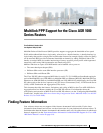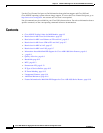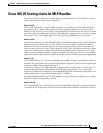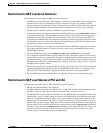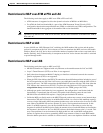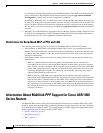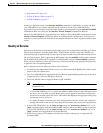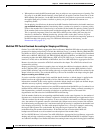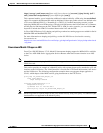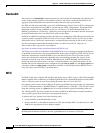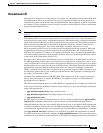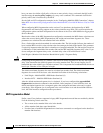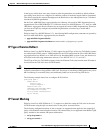
8-8
Cisco ASR 1000 Series Aggregation Services Routers Software Configuration Guide
OL-16506-17
Chapter 8 Multilink PPP Support for the Cisco ASR 1000 Series Routers
Information About Multilink PPP Support for Cisco ASR 1000 Series Routers
over and begin affecting packet buffering on other MLP bundles. (The MLP lost-fragment timeout
can be configured on the multilink virtual template interface using the ppp timeout multilink
lost-fragment (seconds) (milliseconds) configuration command).
By default, in MLPoLNS, the Cisco IOS XE software informs the MLP that packets may arrive out
of order. This works well for upstream traffic, but does not address the order issue at the peer CPE
device. The peer CPE device should also be configured to allow for receipt of out-of-order packets.
In Cisco devices, this can be managed by configuring the ppp link reorders command at the bundle
interface.
• When the Cisco ASR 1000 Series Aggregation Services Routers function as both a PTA device and
an LNS device simultaneously, locally terminated member links (PTA) and member links that are
forwarded from the LAC are not supported within the same bundle.
Restrictions for Broadband MLP at PTA and LNS
The following restrictions apply to all variations of broadband MLP at PTA and LNS modes:
• When defining an MLP bundle with multiple member-link sessions, we recommend that all the
member-link sessions utilize the same physical interface or subinterface. If other broadband sessions
are sharing the same interface, ensure that all the member-link sessions utilize the same physical
interface or subinterface.
• The following issues might occur because of splitting links across separate physical interfaces or
subinterfaces:
–
MLP is a sequenced protocol and all the packets and fragments must be reordered and
reassembled at the receiver, based on the MLP sequence number before the receiver forwards
them. In such a scenario, packets traversing separate physical interfaces may cause additional
packet latency disparity between links due to transmission delays and other issues associated
with using multiple physical paths. The reordering and reassembly processing may require
additional MLP buffering at the receiver.
–
MLP on the Cisco ASR 1000 Series Aggregation Services Routers performs congestion
management of the MLP bundle based on the congestion state of the member-link sessions that
make up the bundle. If member-links are distributed across multiple interfaces and sufficient
congestion is detected in one or more member links, the bundle may be back pressured due to
the congestion even if all the links in the bundle are not congested. By keeping all the links on
the same physical interface or subinterface, the chance of back pressure due to one link being
congested is reduced.
Information About Multilink PPP Support for Cisco ASR 1000
Series Routers
The Multilink PPP feature provides the load-balancing functionality over multiple WAN links, while
providing multivendor interoperability, packet fragmentation, proper sequencing, and load calculation
for both inbound and outbound traffic. Cisco implementation of MLP supports the fragmentation and
packet-sequencing specifications described in RFC 1990.
• Quality of Service, page 8-9
• Bandwidth, page 8-12
• MTU, page 8-12




